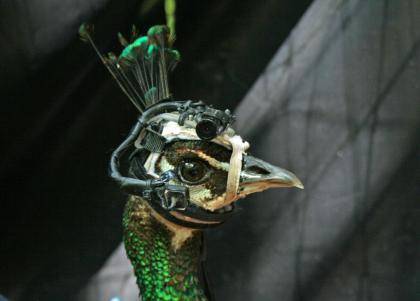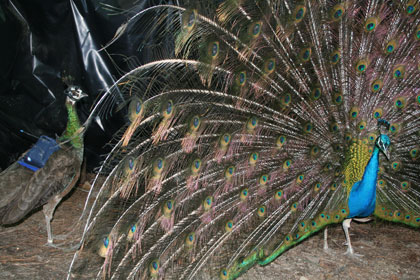
Looking like vision-enhanced cyborgs from some futuristic sci-fi thriller, peahens have been showing biologists just what it is they see in a peacock's elaborate feathered display.
The eye tracker, a headmounted two-camera system with battery pack and wireless signal, is the brainchild of graduate student Jessica Yorzinski, who wanted to know specifically what the hens see in these guys. She did the research at Duke, housing nearly 50 birds on a retired biology professor's farm near campus, but her doctorate for the work was awarded by UC Davis.
"This is the first study to ask the females what they're really attending to," Yorzinski says. The bottom line is that the females only spend 20-30 percent of their gaze on the fervently displaying males.
The flamboyant feathered display of the male peacock, measuring more than a meter high and a meter wide, caused problems for Charles Darwin as he was devising his theory of evolution. Clearly the gaudy display wasn't helping peacocks evade predators or get more food -- quite the contrary. So what is it for? Darwin proposed that there was a further layer of natural selection, which he called sexual selection, that would account for such ungainly and expensive displays.


For her dissertation research, Yorzinski watched wild peacocks romping in the field in India and in vacant lots in California and Florida before devising a series of controlled experiments with captive birds to figure out the specifics. "It took a long time to come up with the exact way to keep the eye-tracker on her head," Yorzinski said.
The finished design is a plastic cap held in place by velcro straps holding two cameras and an infrared LED. It weighs about 25 grams. On her back, the bird wears a smart little backpack containing batteries and the equipment to broadcast her two-camera video to a nearby computer and DVD recorder. The pack weighs 345 grams (three-quarters of a pound), which the females were gradually accustomed to wearing by adding progressive amounts of weight.
It took some tinkering and adjusting to make sure the tiny cameras were accurately aimed at the bird's eye and at what she was supposedly looking at. Tossing bottle caps and other objects near the birds, and introducing a taxidermied raccoon, further validated that the video was a bird's eye view of the action.
After 39 videotaped trials, the answers are in. The girls aren't looking at the guy's head or the highest reaches of his magnificent fan. Rather, they look at the lowest edge of the display and when he turns around during the courtship dance, how he shakes his wings.
In a natural environment with high grasses, the top of the peacock's fan seems to be useful for hailing females at a distance to the dancing area, called a lek. But once she's in the lek, where the real selection happens, she's looking at the lower portion of the display. He shakes and dances and makes a rattling sound to help hold her attention.
Yorzinski speculates that the peahens are assessing the size and symmetry of the lower portion of the male’s display. Until a male is five years old, his train grows slightly larger each year, so size would matter for finding the older guys, she says.
Yorzinski has just moved to Purdue University for a post-doctoral fellowship, but her birds are still in North Carolina. Once she's got them moved, the next phase of the experiments will entail altering the males' displays with scissors, added eyes, or artificial colors to see what variables matter most. Males grow a new fan every year, so the bad haircuts won't do them any harm, she says.
CITATION: "Through their eyes: selective attention in peahens during courtship," Jessica Yorzinski, Gail Patricelli, Jason Babcock, John Pearson, Michael Platt. Journal of Experimental Biology, July 24, 2013.